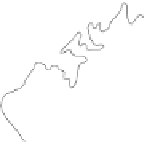Geography Reference
In-Depth Information
60
°
CANADA
UNITED STATES
40°
40°
A
ATLANTIC
OCEAN
Tropic of Cancer
20°
20°
20°
PACIFIC
0°
Equator
OCEAN
WORLD POPULATION
DENSITY
Inhabitants
Per square
mile
20°
20°
20°
Per square
kilometer
Tropic of Capricorn
100 or more
250 or more
50-99
125-249
40°
40°
40°
40°
25-49
60-124
10-24
25-59
1-10
2--24
40°
160°
140°
120°
80°
60°
under 1
under 2
60°
60°
60°
60°
SOUTHERN
OCEAN
2000
0
1000
3000 Kilometers
0
1000
2000 Miles
Figure 2.6
World Population Density.
© H. J. de Blij, P. O. Muller, and John Wiley & Sons, Inc.
number of congressional seats allotted to each state is
based on the census counts.
Advocacy groups urged the census in 2000 and again
in 2010 to sample the population and derive population sta-
tistics from the samples. They argued that this would more
accurately represent the true number of people in the
United States. The United States Census Bureau contin-
ued to conduct its census as it always has, trying to count
each individual in its borders.
If a prosperous country such as the United States has
problems conducting an accurate census, imagine the dif-
fi culties that must be overcome in less well-off countries.
The cost, organization, and reporting of a census go
beyond what many countries can afford or handle.
Several agencies collect data on world population. The
United Nations records offi cial statistics that national govern-
ments assemble and report. The World Bank and the Popula-
tion Reference Bureau also gather and generate data and report
on the population of the world and of individual countries.
If you compare the population data reported by each
of these sources, you will fi nd inconsistencies in the data.
Data on population, growth rates, food availability, health
conditions, and incomes are often informed estimates
rather than actual counts.























































































































































































































































































































































































































































































































































































































































